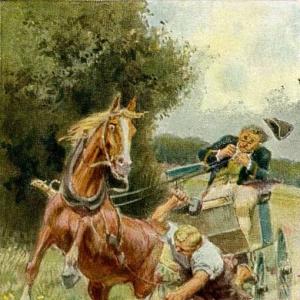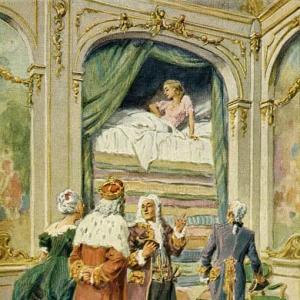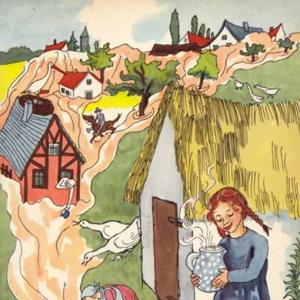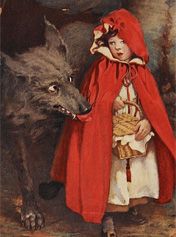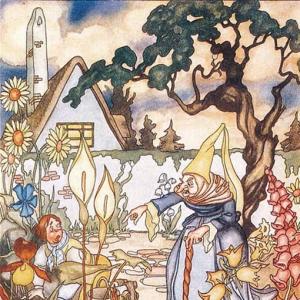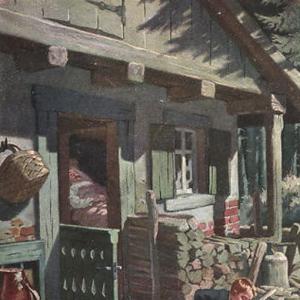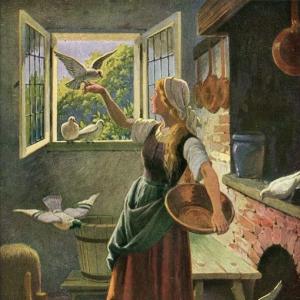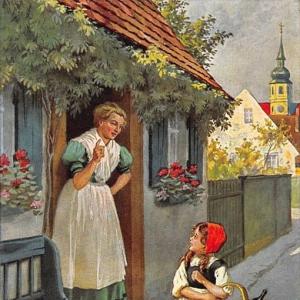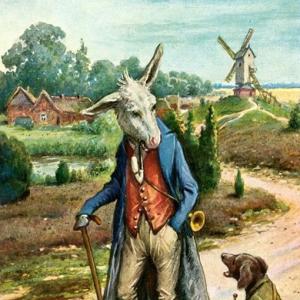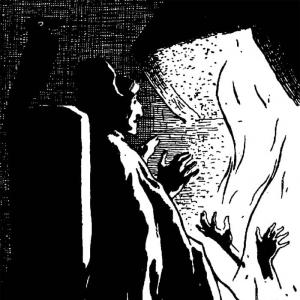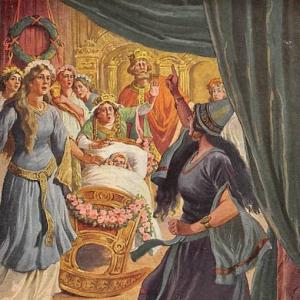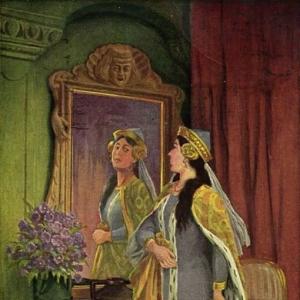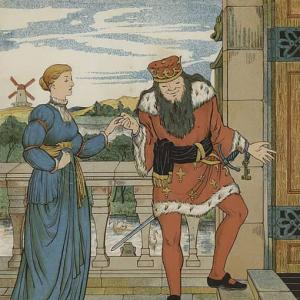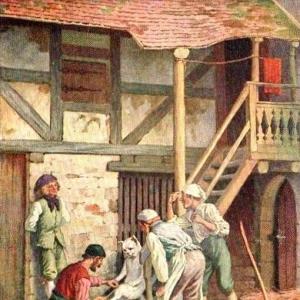Reading time: 11 min
Now listen! In the country, close by the high road, stood a farmhouse; perhaps you have passed by and seen it yourself. There was a little flower garden with painted wooden palings in front of it; close by was a ditch, on its fresh green bank grew a little daisy. The sun shone as warmly and brightly upon it as on the magnificent garden flowers, and therefore it thrived well. One morning it had quite opened, and its little snow-white petals stood round the yellow centre, like the rays of the sun. It did not mind that nobody saw it in the grass, and that it was a poor despised flower. On the contrary, it was quite happy, and turned towards the sun, looking upward and listening to the song of the lark high up in the air.
The little daisy was as happy as if the day had been a great holiday, but it was only Monday. All the children were at school, and while they were sitting on the forms and learning their lessons, it sat on its thin green stalk and learnt from the sun and from its surroundings how kind God is, and it rejoiced that the song of the little lark expressed so sweetly and distinctly its own feelings. With a sort of reverence the daisy looked up to the bird that could fly and sing, but it did not feel envious. „I can see and hear,“ it thought; „the sun shines upon me, and the forest kisses me. How rich I am!“
In the garden close by grew many large and magnificent flowers, and, strange to say, the less fragrance they had the haughtier and prouder they were. The peonies puffed themselves up in order to be larger than the roses, but size is not everything! The tulips had the finest colours, and they knew it well, too, for they were standing bolt upright like candles, that one might see them the better. In their pride they did not see the little daisy, which looked over to them and thought, „How rich and beautiful they are! I am sure the pretty bird will fly down and call upon them. Thank God, that I stand so near and can at least see all the splendour.“ And while the daisy was still thinking, the lark came flying down, crying „Tweet,“ but not to the peonies and tulips– no, into the grass to the poor daisy. Its joy was so great that it did not know what to think. The little bird hopped round it and sang, „How beautifully soft the grass is, and what a lovely little flower with its golden heart and silver dress is growing here.“ The yellow centre in the daisy did indeed look like gold, while the little petals shone as brightly as silver.
How happy the daisy was! No one has the least idea. The bird kissed it with its beak, sang to it, and then rose again up to the blue sky. It was certainly more than a quarter of an hour before the daisy recovered its senses. Half ashamed, yet glad at heart, it looked over to the other flowers in the garden; surely they had witnessed its pleasure and the honour that had been done to it. They understood its joy. But the tulips stood more stiffly than ever, their faces were pointed and red, because they were vexed. The peonies were sulky. It was well that they could not speak, otherwise they would have given the daisy a good lecture. The little flower could very well see that they were ill at ease, and pitied them sincerely.
Shortly after this a girl came into the garden, with a large sharp knife. She went to the tulips and began cutting them off, one after another. „Ugh!“ sighed the daisy, „that is terrible. Now they are done for.“
The girl carried the tulips away. The daisy was glad that it was outside, and only a small flower– it felt very grateful. At sunset it folded its petals, and fell asleep, and dreamt all night of the sun and the little bird.
On the following morning, when the flower once more stretched forth its tender petals, like little arms, towards the air and light, the daisy recognised the bird’s voice, but what it sang sounded so sad. Indeed the poor bird had good reason to be sad, for it had been caught and put into a cage close by the open window. It sang of the happy days when it could merrily fly about, of fresh green corn in the fields, and of the time when it could soar almost up to the clouds. The poor lark was most unhappy as a prisoner in a cage. The little daisy would have liked so much to help it, but what could be done? Indeed, that was very difficult for such a small flower to find out. It entirely forgot how beautiful everything around it was, how warmly the sun was shining, and how splendidly white its own petals were. It could only think of the poor captive bird, for which it could do nothing. Then two little boys came out of the garden. One of them had a large sharp knife, like that with which the girl had cut the tulips. They came straight towards the little daisy, which could not understand what they wanted.
„Here is a fine piece of turf for the lark,“ said one of the boys, and began to cut out a square round the daisy, so that it remained in the centre of the grass.
„Pluck the flower off“ said the other boy, and the daisy trembled for fear, for to be pulled off meant death to it; and it wished so much to live, as it was to go with the square of turf into the poor captive lark’s cage.
„No let it stay,“ said the other boy, „it looks so pretty.“
And so it stayed, and was brought into the lark’s cage. The poor bird was lamenting its lost liberty, and beating its wings against the wires; and the little daisy could not speak or utter a consoling word, much as it would have liked to do so. So the forenoon passed.
„I have no water,“ said the captive lark, „they have all gone out, and forgotten to give me anything to drink. My throat is dry and burning. I feel as if I had fire and ice within me, and the air is so oppressive. Alas! I must die, and part with the warm sunshine, the fresh green meadows, and all the beauty that God has created.“ And it thrust its beak into the piece of grass, to refresh itself a little. Then it noticed the little daisy, and nodded to it, and kissed it with its beak and said: „You must also fade in here, poor little flower. You and the piece of grass are all they have given me in exchange for the whole world, which I enjoyed outside. Each little blade of grass shall be a green tree for me, each of your white petals a fragrant flower. Alas! you only remind me of what I have lost.“
„I wish I could console the poor lark,“ thought the daisy. It could not move one of its leaves, but the fragrance of its delicate petals streamed forth, and was much stronger than such flowers usually have: the bird noticed it, although it was dying with thirst, and in its pain tore up the green blades of grass, but did not touch the flower.
The evening came, and nobody appeared to bring the poor bird a drop of water. It opened its beautiful wings, and fluttered about in its anguish; a faint and mournful „Tweet, tweet,“ was all it could utter, then it bent its little head towards the flower, and its heart broke for want and longing. The flower could not, as on the previous evening, fold up its petals and sleep. It dropped sorrowfully. The boys only came the next morning. When they saw the dead bird, they began to cry bitterly, dug a nice grave for it, and adorned it with flowers. The bird’s body was placed in a pretty red box. They wished to bury it with royal honours. While it was alive and sang they forgot it, and let it suffer want in the cage; now, they cried over it and covered it with flowers. The piece of turf, with the little daisy in it, was thrown out on the dusty highway. Nobody thought of the flower which had felt so much for the bird and had so greatly desired to comfort it.
 Learn languages. Double-tap on a word.Learn languages in context with Childstories.org and Deepl.com.
Learn languages. Double-tap on a word.Learn languages in context with Childstories.org and Deepl.com.Backgrounds
Interpretations
Adaptions
Summary
Linguistics
„The Daisy“ is a fairy tale written by Danish author Hans Christian Andersen. Born in 1805, Andersen became one of the most famous and influential authors of his time, particularly known for his fairy tales. His works have been translated into numerous languages, and many of his stories have been adapted into films, ballets, and plays.
Andersen’s fairy tales often contain moral lessons and explore themes such as beauty, simplicity, empathy, and the fleeting nature of life. Some of his other famous works include „The Little Mermaid,“ „The Ugly Duckling,“ „The Emperor’s New Clothes,“ and „The Snow Queen.“
„The Daisy“ was first published in 1861 as a part of a collection of Andersen’s fairy tales. Like many of his other stories, „The Daisy“ uses simple, relatable characters and settings to convey deeper themes and messages, making it an enduring and beloved tale.
„The Daisy“ can be interpreted in several ways, touching on themes of simplicity, empathy, appreciation, and the fleeting nature of beauty and life.
Simplicity and contentment: The daisy is a simple, unassuming flower that finds happiness in its humble existence. This contrasts with the garden flowers, which are prideful and boastful despite their beauty. The story suggests that true happiness comes from appreciating what we have and not longing for more.
Empathy and compassion: The daisy is the only one to truly feel for the lark’s suffering and wishes to help. The daisy’s empathy and compassion for the lark are a lesson in the importance of caring for others, even when we may seem insignificant or powerless.
Appreciation of beauty and nature: The daisy and the lark represent the beauty and wonders of nature. The story serves as a reminder to appreciate the simple pleasures in life and to take the time to notice and enjoy the world around us.
Fleeting nature of beauty and life: The garden flowers, despite their beauty, are short-lived and quickly forgotten. The lark, too, suffers a tragic fate. The story reminds us that beauty and life are fleeting and that we should cherish and appreciate them while they last.
Irony and human nature: The boys and the girl in the story are oblivious to the lark’s suffering and the daisy’s empathy, only showing concern after the bird has died. This highlights the irony of human nature, where people often overlook the struggles of others and only pay attention after it’s too late.
„The Daisy“ by Hans Christian Andersen has been adapted into various forms of media over the years, including plays, movies, and musicals. Here are some notable adaptations:
„The Daisy“ (1972 film): This Danish film adaptation of the fairy tale was directed by Erik Balling and starred Kirsten Walther as the voice of the daisy. The movie follows the original story closely and features beautiful animated sequences depicting the daisy’s journey.
„The Daisy“ (2012 play): This stage adaptation of the story was created by British playwright Phil Porter and was performed at the Unicorn Theater in London. The play expands on the original tale, adding new characters and plot points, and explores themes of friendship and the power of imagination.
„The Daisy“ (2014 musical): This musical adaptation of the story was created by British composer and lyricist Guy Chambers and was performed at the Charing Cross Theater in London. The show features a cast of talented actors and musicians, and includes original songs inspired by the themes and characters of the fairy tale.
„The Daisy“ (2020 picture book): This beautifully illustrated picture book adaptation of the story was created by author and illustrator Caroline Mockford. The book features stunning watercolor illustrations that bring the daisy’s journey to life, and is a perfect introduction to the classic fairy tale for young readers.
Overall, „The Daisy“ has inspired numerous adaptations over the years, each bringing its own unique perspective and interpretation to the timeless tale of self-acceptance and the beauty of nature.
„The Daisy“ is a fairy tale by Hans Christian Andersen that tells the story of a humble little daisy growing near a beautiful flower garden. The daisy is content with its simple life, basking in the sun and listening to the song of a lark. The garden flowers, though more extravagant, are prideful and vain. The daisy admires their beauty, but does not envy them.
One day, a girl cuts off the tulips in the garden, leaving the daisy grateful for its simplicity. That night, the daisy dreams of the sun and the lark. The next day, it hears the lark’s sad song from a cage by the window. The bird is a prisoner, longing for its freedom, and the daisy wishes it could help.
Two boys come to the garden and decide to bring a piece of turf with the daisy on it to the lark’s cage. The daisy is glad it can be near the bird, even though it cannot speak or console the lark. The lark, suffering from thirst and longing for freedom, acknowledges the daisy’s presence and laments the loss of its world outside.
The daisy tries to comfort the lark with its fragrance but cannot quench the bird’s thirst. When the boys finally return the next day, they find the lark dead. They cry over the bird and give it a grand burial, adorned with flowers. The piece of turf with the daisy is discarded on the dusty highway, forgotten despite the little flower’s empathy for the bird and its desire to help.
Hans Christian Andersen’s fairy tale „The Daisy“ is imbued with rich linguistic and thematic elements that contribute to its enduring significance.
Here’s a linguistic analysis focusing on the story:
Lexical Choices and Imagery
Descriptive Imagery: Andersen uses vivid descriptions to create imagery that transports readers to the idyllic countryside where the daisy grows. Phrases like „fresh green bank,“ „snow-white petals,“ and „golden heart and silver dress“ evoke a pastoral beauty and innocence.
Personification: The daisy and other elements of nature are given human-like qualities. The daisy „did not mind“ being unseen and „rejoiced“ in the sun and lark’s song. Such personification evokes empathy from readers, inviting them to view the world from the flower’s perspective.
Contrasts and Comparisons: Andersen contrasts the modest, humble daisy with the „large and magnificent flowers“ in the nearby garden to highlight themes of humility and pride. The peonies and tulips are described as „haughty“ and „proud,“ reflecting vanity and superficiality compared to the daisy’s simplicity and contentment.
Themes
Innocence and Contentment: The daisy’s happiness and lack of envy highlight a theme of contentment with one’s station and an appreciation for the simple pleasures of life, in contrast to the more ostentatious garden flowers.
Nature’s Inequities: The narrative demonstrates how nature and beauty can exist outside of societal recognition or validation. The daisy’s quiet joy and the lark’s songs are independent of the notice of the grander, prouder flowers.
Sympathy and Empathy: The relationship between the daisy and the lark embodies pure empathy. The daisy wants to comfort the captive lark, showing sensitivity to its plight despite its inability to help, resonating with the moral of compassion for others.
Structural Elements
Narrative Structure: The story follows a simple chronological order that takes the reader through the major events affecting the daisy—from its happy life in the grass, its interaction with the lark, to its final displacement.
Use of Dialogue: Direct speech, particularly from the lark, adds an emotional layer to the narrative. The lark’s lamentations underscore the themes of freedom and the loss thereof, adding depth to the story’s exploration of captivity versus freedom.
Symbolism: The daisy symbolizes purity, innocence, and unrecognized beauty. Its interaction with the lark and its empathetic role further enhances its symbolic representation of kindness and unselfish love.
Societal Reflection
Through the narrative, Andersen subtly critiques human tendencies to overlook simple, essential beauty until it’s lost, as demonstrated by the boys’ neglect of the lark’s needs and their subsequent regret. The tale encourages reflection on the value of appreciating simple, often unnoticed virtues in life.
In essence, „The Daisy“ uses linguistic elements and narrative techniques to explore themes of simplicity, beauty, empathy, and societal values, creating a compelling moral lesson wrapped in a beautifully told fairy tale.
Information for scientific analysis
Fairy tale statistics | Value |
|---|---|
| Translations | DE, EN, DA, ES, FR, IT, NL |
| Readability Index by Björnsson | 28.4 |
| Flesch-Reading-Ease Index | 81.1 |
| Flesch–Kincaid Grade-Level | 6.4 |
| Gunning Fog Index | 8.7 |
| Coleman–Liau Index | 8 |
| SMOG Index | 8 |
| Automated Readability Index | 6.6 |
| Character Count | 7.636 |
| Letter Count | 5.899 |
| Sentence Count | 81 |
| Word Count | 1.457 |
| Average Words per Sentence | 17,99 |
| Words with more than 6 letters | 152 |
| Percentage of long words | 10.4% |
| Number of Syllables | 1.851 |
| Average Syllables per Word | 1,27 |
| Words with three Syllables | 55 |
| Percentage Words with three Syllables | 3.8% |

 Facebook
Facebook  Whatsapp
Whatsapp  Messenger
Messenger  Telegram
Telegram Reddit
Reddit